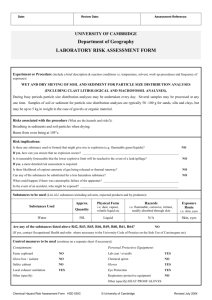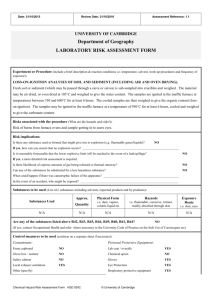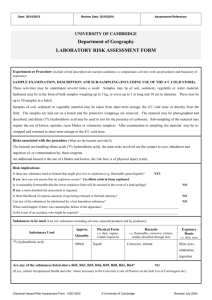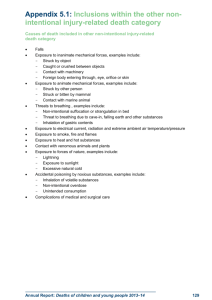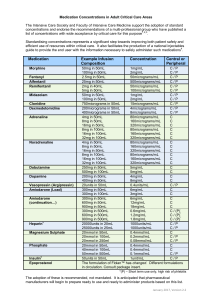Microscope use - University of Cambridge Department of Geography
advertisement
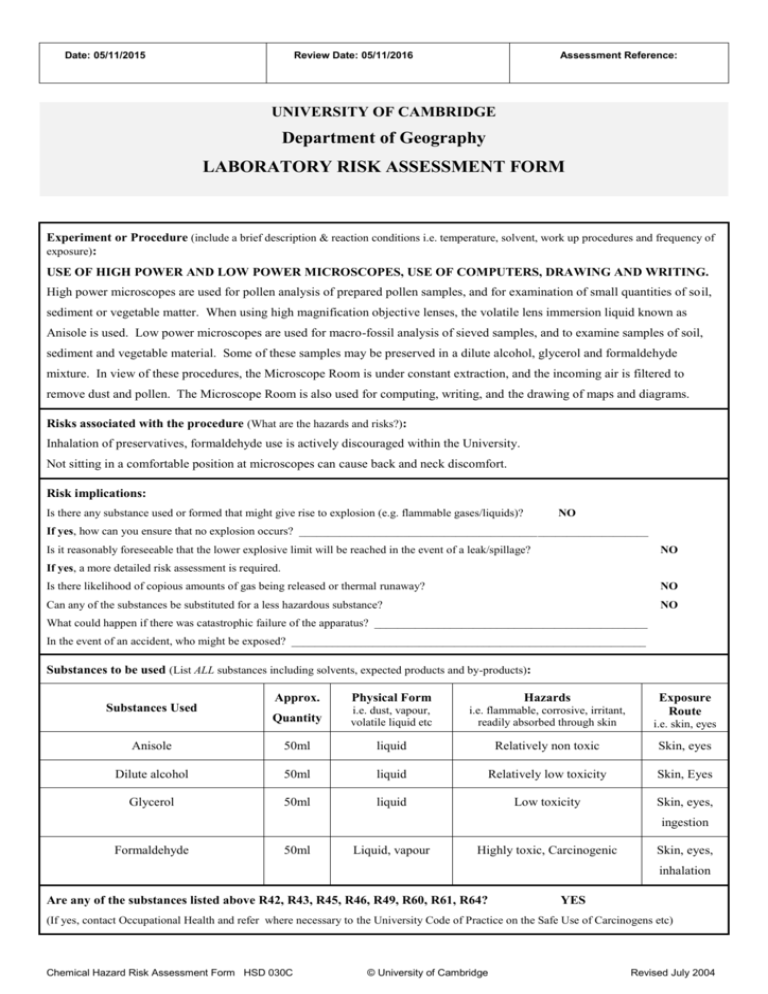
Date: 05/11/2015 Review Date: 05/11/2016 Assessment Reference: UNIVERSITY OF CAMBRIDGE Department of Geography LABORATORY RISK ASSESSMENT FORM Experiment or Procedure (include a brief description & reaction conditions i.e. temperature, solvent, work up procedures and frequency of exposure): USE OF HIGH POWER AND LOW POWER MICROSCOPES, USE OF COMPUTERS, DRAWING AND WRITING. High power microscopes are used for pollen analysis of prepared pollen samples, and for examination of small quantities of soil, sediment or vegetable matter. When using high magnification objective lenses, the volatile lens immersion liquid known as Anisole is used. Low power microscopes are used for macro-fossil analysis of sieved samples, and to examine samples of soil, sediment and vegetable material. Some of these samples may be preserved in a dilute alcohol, glycerol and formaldehyde mixture. In view of these procedures, the Microscope Room is under constant extraction, and the incoming air is filtered to remove dust and pollen. The Microscope Room is also used for computing, writing, and the drawing of maps and diagrams. Risks associated with the procedure (What are the hazards and risks?): Inhalation of preservatives, formaldehyde use is actively discouraged within the University. Not sitting in a comfortable position at microscopes can cause back and neck discomfort. Risk implications: Is there any substance used or formed that might give rise to explosion (e.g. flammable gases/liquids)? NO If yes, how can you ensure that no explosion occurs? ____________________________________________________________ Is it reasonably foreseeable that the lower explosive limit will be reached in the event of a leak/spillage? NO If yes, a more detailed risk assessment is required. Is there likelihood of copious amounts of gas being released or thermal runaway? NO Can any of the substances be substituted for a less hazardous substance? NO What could happen if there was catastrophic failure of the apparatus? _______________________________________________ In the event of an accident, who might be exposed? _____________________________________________________________ Substances to be used (List ALL substances including solvents, expected products and by-products): Approx. Physical Form Hazards Quantity i.e. dust, vapour, volatile liquid etc i.e. flammable, corrosive, irritant, readily absorbed through skin i.e. skin, eyes Anisole 50ml liquid Relatively non toxic Skin, eyes Dilute alcohol 50ml liquid Relatively low toxicity Skin, Eyes Glycerol 50ml liquid Low toxicity Skin, eyes, Substances Used Exposure Route ingestion Formaldehyde 50ml Liquid, vapour Highly toxic, Carcinogenic Skin, eyes, inhalation Are any of the substances listed above R42, R43, R45, R46, R49, R60, R61, R64? YES (If yes, contact Occupational Health and refer where necessary to the University Code of Practice on the Safe Use of Carcinogens etc) Chemical Hazard Risk Assessment Form HSD 030C © University of Cambridge Revised July 2004 Control measures to be used (continue on a separate sheet if necessary): Containment: Personal Protective Equipment: Fume cupboard YES Lab coat / overalls YES Glove box / isolator NO Chemical apron NO Safety cabinet NO Gloves YES Local exhaust ventilation YES Eye Protection YES Respiratory protective equipment NO Other (specify) Other (specify) N/A Are any additional controls required? (Consider nearby sources of ignition, formation of explosive atmospheres/mixtures, asphyxiation in confined spaces) Lab coat, gloves and eye protection are the minimum required personal protection for all reagent use. Formaldehyde (also known as formalin) must be used in the fume cupboard. Disposal measures to be used during and after the procedure: (Also consider by-products and washings) Glass slides must be disposed of in the yellow sharps/hazard bins located in the each laboratory. Emergency Procedures (emphasise any special hazards): Shutdown Procedures: If spillage of chemicals, wipe up with blue roll and flush with water. Action in the event of fire (type of fire extinguisher):Powder Action in the event of spillage or uncontrolled release: If chemical can be wiped up proceed and neutralise with copious amounts of water. Emergency treatment for personnel in the event of contamination, exposure to fumes or other adverse effects Eyes: Irrigate with cool clean water for at least 20 minutes, summon first aid, send to A & E Unit at Addenbrookes Hospital. Skin: wash with copious amounts of water seek, medical attention Inhalation: If inhaled seek fresh air until symptoms pass Name of assessor: Signature: Date: Name of co-signatory: (e.g. Supervisor / authorised deputy) Signature: Date: Note: This risk assessment should be reviewed at least annually and when there is any significant change in procedure. Chemical Hazard Risk Assessment Form HSD 030C © University of Cambridge Revised July 2004
